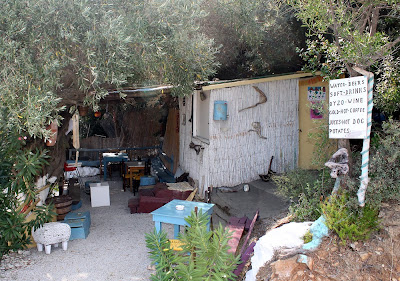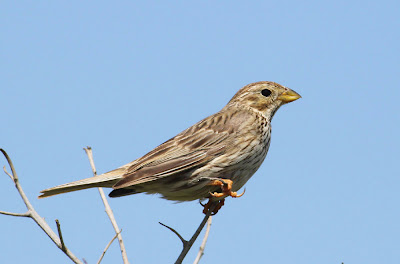What a surpise! It's raining hard again so here's another post about Greece.
In Skiathos we took a ride out one morning over the island peaks, crashing over rough, dusty unmade tracks to distant Cape Kastro, the ancient fortified settlement located on high rocks at the northernmost point of the island. (Kastro is the Greek word for castle). It was here in the mid-14th century that the inhabitants of Skiathos moved to when their previous fortress The Bourtzi proved ineffective in protecting the island from pirates.
The Bourtzi is now a major element of the Skiathos Town scene, where weddings take place and tourists sit to drink coffee whilst watching the world go by and marvel at planes flying into the airport just half a mile away.
The Bourtzi, Skiathos, viewed from Skaithos Old Harbour
A day or two earlier there had been brief views of an Eleanora's above an island near to Skiathos Aiprot where Hooded Crows drew attention to the falcon, mobbing it mercilessly until the falcon flew off into the distance. Also briefly we saw one alongside the cliffs on the boat journey to Skopelos.
Apart from the hairy ride in the battered old Jimny, the attraction once
at Kastro was the chance of seeing more than one Eleanora’s Falcon,
Falco eleonorae. Eleanora’s Falcon is unique in that it is one of the few species that breeds during early autumn, feeding its chicks with other migratory birds in abundance during that period. It is also one of the few falcon species that creates breeding colonies.
The species breeds on islands in the Mediterranean particularly off Greece where two-thirds of the world's population breeds, but also in the Canary Islands, Ibiza and off Spain, Italy, Croatia, Morocco and Algeria. With its long pointed wings, long tail and slim body Eleonora's Falcon is an elegant bird of prey similar in shape to a large Eurasian Hobby or a small slender Peregrine Falcon. The call is a typical call of most falcons, a high-pitched kek-kek-kek, calls we would hear continuously when we finally arrived at Kastro after our bone-shaking journey.
Suzuki Jimny
Looking Back - Skiathos
After trekking up and over the rocks then through the ancient remains we reached the topmost point of Kastro from where we could see and hear the Eleanora’s, still a hundred yards away on their secluded and insurmountable stacks of rock. The birds were extremely active and obviously in the throes of breeding, with as many as eight in the air at once and perhaps 15 or more flying above and about the still mountainous rocks beyond our spot. We watched as at least one bird visited rocky ledges where youngsters were located.
There was much calling amid spectacular headlong plunges and interaction between individual birds as they dived towards the rocks and the sea before disappearing out of sight or climbing back to eye level to cruise along the cliff face once more.. All the time the birds kept their distance from the well walked paths of the tourists but there was no way to get any closer to these magical falcons. It is impossible to describe how wonderful it was to watch so many Eleanora’s Falcons in action at once, but I found a video on You Tube, a video also shot in Greece. Unfortunately it dosn't have the sounds of the falcons.
Eleanora's Falcon
Eleanora's Falcon
Kastro, Skiathos
Eleanora's Falcon
Fortress - Kastro, Skiathos
In such a hostile environment it was not surprising to find few other birds and although Yellow-legged Gulls were abundant, other birds here were limited to Chaffinch, Sardinian Warbler, Blackcap, Common Kestrel and European Shag.
Sardinian Warbler
European Shag
Common Kestrel
You can’t go far in Skiathos without encountering a taverna, and here seemingly at the end of the earth was a less than trendy one, but welcoming indeed after our tiring thirsty hike through Ancient Greece.
A taverna - Kastro, Skiathos
More birding adventures soon from Another Bird Blog. Now go back and 'click the pics' to revisit Skiathos. Linking today to
Anni's Blog .






























































































